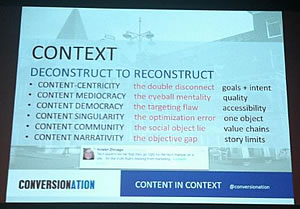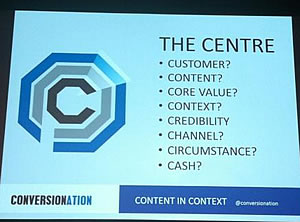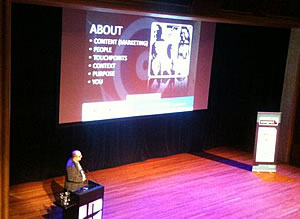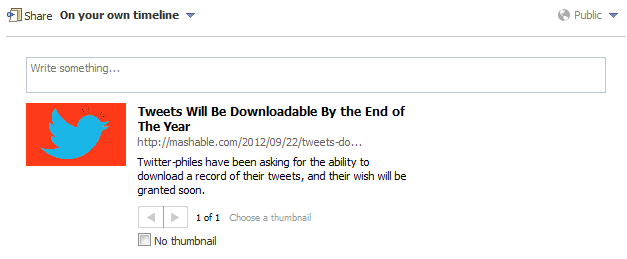At the Customer Media Conference in Haarlem, The Netherlands, I presented a keynote on content marketing in context. The topic of content in context has been on my mind since over a year now.

We have been saying content is king for a long time. About a decade ago, it made sense. Businesses were building websites without relevant content too often. It was the age of brochureware.
Today, content and content marketing are hot topics. However, we should let go of some myths, as I will tackle them in a follow-up post, and of the increasing content-centricity which I see happening all around me. It’s time to deconstruct in order to reconstruct and reconnect.
What matters in content marketing
What’s at the center of marketing efforts? It’s not content. Who or what is king? Content? Customer? Channels? Context? Cash (goals)? As a matter of fact, I’m fed up with the ‘this is king’ messages. Everything deserves attention in a world where optimizing is crucial and overlooked all too often.

In the end you optimize for two reasons:
- Customers, in the broadest sense of the word (e.g. also the customers or connections of your customers/readers/connections). Or better: customer value and the customer experience overall in a connected context.
- Goals – business value goals, achieved by making people achieve theirs goals That’s why I advised everyone at the conference to read Ram Charan’s ‘What the Customer Wants You To Know’. It is and always has been about chains of value as I have been covering before.
At the same time, we should start deconstructing what content really is. Just as we should look deeper into the meaning of words such as customer, media, channels, community, touchpoints, intent and preference. We use them too easily until they become concepts, we base our strategies on. But they’re dynamic, always changing and richer than we think if looking closely at them.
What is behind customer preferences? What are media? What defines a touchpoint and makes it relevant?
Content singularity
Let me give you an example. We often look at content as a social object people can interact with and/or as a chunk of information that is seen as one. I call it content singularity.
Take a blog post, for instance. Normally it’s written with an audience and goal in mind. If we’re good, we also pick a style, tone of voice, topic and context that matches the preference and need of the reader we would like to ‘touch’. It can be pure information during a specific stage of the buying journey (where content is more than ever key), entertainment or whatever else – mainly emotional – goal. But we look at it as one single piece of content.
When dissecting it we can do much more with our content if we put it in context. This context can be very broad and encompass many elements: emotion, reading or ‘consumption’ environment, time, intent, previous interactions, cross-channel behavior, etc.

Furthermore, a singular view on content cannot be sustained in times when information channels are ubiquitous and the sheer volume of content is exploding. This is also the case in other areas than marketing. Think about media, for instance, and even books, movies, etc. The cost of the single content item or production becomes too high, certainly when it’s not “created” for a very specific intent, goal and “consumer”. That’s also where intelligent content and dynamic content come in.
Content needs to be atomized and, once it’s broken up in pieces of significance with the metadata describing that significance, reconstructed. And the same needs to happen with the valuable interactions that are created around that content by the people sharing and using it to create their significance. So, I’m not talking about repurposing here, even if there are overlaps. I’m talking about looking beyond the content as a single item but also at the individual contextual acts of creation, sharing, commenting etc. of the broader connected context of people and interactions.
It’s a vast topic. I guess it’s not a coincidence I felt that my presentation only touched 10% of what I wanted to share when I finished it (and that after showing my fourth slide or so, I only had 5 minutes to go). We all create content all the time. The people who have been tweeting at the event, the pictures of Haarlem I took the evening before to make my presentation more contextual, the tweets sent by people that said they would attend the conference and thus gave me an indication of who they were and what they wanted are an example. I also used the Twitter profiles of these people in my presentation, again contextual relevance (and emotional connection). Finally, their pictures are illustrating this blog. I guess you get the point.
Sharing content is creating content (and ripples)
One of the points I wanted to make is that content in context also means that each chunk of content we share is a social object and content as such. The act of sharing content should also be seen as an act of creating content that requires context. As other speakers will now, often the things people tweet don’t correspond with what we actually mean.
And the same goes for blog posts or other forms of (mainly but not only) digital content. Content sharing is interpreting and adding context. This is not a challenge, it’s an opportunity. Sharing really is creating.
Your goals and the context in which the content you will create or share gets read/seen should be in your content. You can’t separate both. Furthermore, the style of your content is not only defined by the general best practices and the typical results of content-centric ‘black and white’ thinking. It isn’t always about stories, etc. Sometimes buyers just want plain simple and informative content. Sometimes people want long and exhaustive texts instead of easy snacks.
Take these contextual factors into account when creating content, even if it’s by sharing. You define the message and hashtag in your Tweet. You define the context you add when you share a piece of information on Facebook: you can change the ‘write something’. You can change the headline. You can choose a thumbnail and change the block of text that shows by default.
You shouldn’t change it just for the sake of it or to mislead people but to turn that piece of content into a new one that makes it more relevant and contextual for the people you want to reach.
The example in the screenshot below from Mashable has a clear headline but how many pieces of content don’t? Mashable also took care of the summary but how often do you seen this isn’t done at all? And what if you changed it? You can add that contextual content yourself to be contextually relevant.
Finally, look at the picture. Mashable mentions Twitter CEO Dick Costolo in the post. What if they had put Costolo’s picture in the original post? Or a visual showing something more relevant instead of the stupid Twitter logo I am forced to show (I can of course how nothing at all) if I would share this? I would at least have a choice.

Looking at all these tiny details might seem over the top. But guess what? It’s easy and pays off to look at them. And conversion is about tiny details, as is relevance. Some people want to see faces and others graphics. Adding them in a Facebook share, for instance, can make what you share a piece of content that serves your goals better and is more relevant for your readers/followers/customers.
Every little chunk of content, including a share, is sacred, as long as it’s contextually relevant. That’s content in context: the context of the “audience”, the interactors at “the other side” and their networks. In the end, it’s about optimization and an integrated view on content marketing and other tactics, around the customer and target segments.
This is just a very small example of what you can do once you start putting content in context and dissect and deconstruct. Stay tuned for more.
Thanks Bonnie Dubois, Gitta Bartling, Loes van Dokkum and Lobke Heisen for the pictures you took of the presentation and the content you thus created within your sharing context.
Originally posted on conversionation.net

